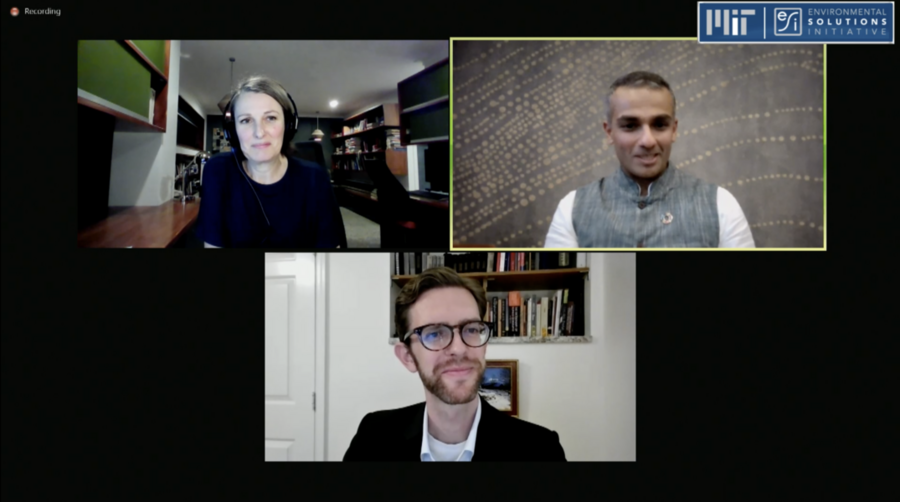In a world powered increasingly by clean energy, drilling for oil and gas will gradually give way to digging for metals and minerals. Today, the “critical minerals” used to make electric cars, solar panels, wind turbines, and grid-scale battery storage are facing soaring demand — and some acute bottlenecks as miners race to catch up.
According to a report from the International Energy Agency, by 2040, the worldwide demand for copper is expected to roughly double; demand for nickel and cobalt will grow at least sixfold; and the world’s hunger for lithium could reach 40 times what we use today.
“Society is looking to the clean energy transition as a way to solve the environmental and social harms of climate change,” says Scott Odell, a visiting scientist at the MIT Environmental Solutions Initiative (ESI), where he helps run the ESI Mining, Environment, and Society Program, who is also a visiting assistant professor at George Washington University. “Yet mining the materials needed for that transition would also cause social and environmental impacts. So we need to look for ways to reduce our demand for minerals, while also improving current mining practices to minimize social and environmental impacts.”
ESI recently hosted the inaugural MIT Conference on Mining, Environment, and Society to discuss how the clean energy transition may affect mining and the people and environments in mining areas. The conference convened representatives of mining companies, environmental and human rights groups, policymakers, and social and natural scientists to identify key concerns and possible collaborative solutions.
“We can’t replace an abusive fossil fuel industry with an abusive mining industry that expands as we move through the energy transition,” said Jim Wormington, a senior researcher at Human Rights Watch, in a panel on the first day of the conference. “There’s a recognition from governments, civil society, and companies that this transition potentially has a really significant human rights and social cost, both in terms of emissions […] but also for communities and workers who are on the front lines of mining.”
That focus on communities and workers was consistent throughout the three-day conference, as participants outlined the economic and social dimensions of standing up large numbers of new mines. Corporate mines can bring large influxes of government revenue and local investment, but the income is volatile and can leave policymakers and communities stranded when production declines or mineral prices fall. On the other hand, “artisanal” mining operations are an important source of critical minerals, but are hard to regulate and subject to abuses from brokers. And large reserves of minerals are found in conservation areas, regions with fragile ecosystems and experiencing water shortages that can be exacerbated by mining, in particular on Indigenous-controlled lands and other places where mine openings are deeply fraught.
“One of the real triggers of conflict is a dissatisfaction with the current model of resource extraction,” said Jocelyn Fraser of the University of British Columbia in a panel discussion. “One that’s failed to support the long-term sustainable development of regions that host mining operations, and yet imposes significant local social and environmental impacts.”
All these challenges point toward solutions in policy and in mining companies’ relationships with the communities where they work. Participants highlighted newer models of mining governance that can create better incentives for the ways mines operate — from full community ownership of mines to recognizing community rights to the benefits of mining to end-of-life planning for mines at the time they open.
Many of the conference speakers also shared technological innovations that may help reduce mining challenges. Some operations are investing in desalination as alternative water sources in water-scarce regions; low-carbon alternatives are emerging to many of the fossil fuel-powered heavy machines that are mainstays of the industry; and work is being done to reclaim valuable minerals from mine tailings, helping to minimize both waste and the need to open new extraction sites.
Increasingly, the mining industry itself is recognizing that reforms will allow it to thrive in a rapid clean-energy transition. “Decarbonization is really a profitability imperative,” said Kareemah Mohammed, managing director for sustainability services at the technology consultancy Accenture, on the conference’s second day. “It’s about securing a low-cost and steady supply of either minerals or metals, but it’s also doing so in an optimal way.”
The three-day conference attracted over 350 attendees, from large mining companies, industry groups, consultancies, multilateral institutions, universities, nongovernmental organizations (NGOs), government, and more. It was held entirely virtually, a choice that helped make the conference not only truly international — participants joined from over 27 countries on six continents — but also accessible to members of nonprofits and professionals in the developing world.
“Many people are concerned about the environmental and social challenges of supplying the clean energy revolution, and we’d heard repeatedly that there wasn’t a forum for government, industry, academia, NGOs, and communities to all sit at the same table and explore collaborative solutions,” says Christopher Noble, ESI’s director of corporate engagement. “Convening, and researching best practices, are roles that universities can play. The conversations at this conference have generated valuable ideas and consensus to pursue three parallel programs: best-in-class models for community engagement, improving ESG metrics and their use, and civil-society contributions to government/industry relations. We are developing these programs to keep the momentum going.”
The MIT Conference on Mining, Environment, and Society was funded, in part, by Accenture, as part of the MIT/Accenture Convergence Initiative. Additional funding was provided by the Inter-American Development Bank.









